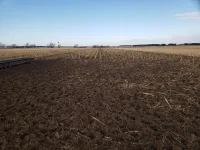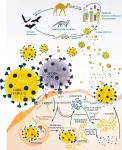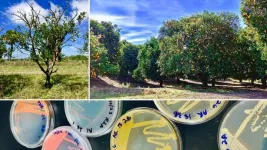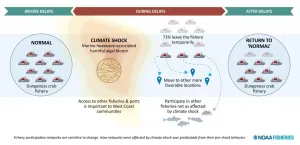(Press-News.org) By late fall, much of the Midwest is a pleasing landscape of dry, harvested corn fields. It makes for a bucolic rural scene on highway drives. But the corn litter that's left over doesn't seem useful, at least to untrained eyes.
But to those in the know, that corn residue is a valuable resource. Scattered leaves, husks, kernels, and cobs can serve as food to grazing cattle. When managed well, corn residue can increase farm income, provide affordable food for cattle, and efficiently use the land to feed people.
Morgan Grabau, a member of the American Society of Agronomy, studies the interactions of cattle grazing and crop productivity. She recently presented her research at the virtual ASA-CSSA-SSSA Annual Meeting.
"Corn residue is an under-used resource. Only 15% of the corn residue acres in the central U.S. are grazed," says Grabau.
One big concern farmers have about cattle grazing corn residue is soil compaction. If cattle compact the soil too much, future crops might not grow well. Addressing the issue of soil compaction is the main focus of Grabau's work.
In the past, Grabau's research team has shown that compaction isn't too bad during fall and winter grazing. When the soil is dry and frozen, it resists stamping cattle hooves. "My research was focused on the effect of grazing in the spring when the soil is thawed and wet," she explains.
Grabau studied two different grazing systems. In one system, researchers let a small number of cattle graze corn fields for 45 days starting in mid-February. The other system tripled the number of cattle but cut grazing time to just 15 days in March. This way, the total amount of grazing was equal. But the time spent on wet fields varied, which could affect how the soil responds to all that trampling.
The researchers studied corn fields in Nebraska, where around half of the corn fields are grazed after harvest. The team measured various soil properties that contribute to compaction and the yield of the soybeans planted in the fields the following season after cattle were done grazing. The team repeated the experiment over two years.
"Much like previous fall grazing studies, minimal effects were seen on soil properties and yield due to spring grazing, regardless of the number of cattle and area grazed," says Grabau.
The soybean productivity of the fields following grazing did show some changes. The highly concentrated grazing for just 15 days actually increased yields slightly.
"This yield increase could be due to more residue removed, causing warmer soil temperatures for plants to grow," Grabau says.
The cattle did cause some soil compaction. But their effects were limited to the surface level of fields.
"Compaction isn't permanent," Grabau says. "Soil can loosen up again as it dries and saturates over and over, and microbial activity in the soil also reduces compaction."
Fortunately, soybean seedlings had no problem establishing themselves in the soil after grazing even with some surface compaction present.
"Even when we created a worst-case scenario, grazing in the spring when the ground was wet, compaction was minimal and subsequent soybean yields were not negatively affected," Grabau says.
Although Grabau says that fall and winter grazing is probably still the best solution, farmers shouldn't be afraid of grazing cattle in the spring.
"The integration of crops and livestock is a beneficial production system," says Grabau. "Grazing cattle on corn residue can be a great way to make even more food for human consumption from corn fields, as both the corn grain and plant residue can be used as feed for livestock."
INFORMATION:
Morgan Grabau is a graduate student in animal science at the University of Nebraska-Lincoln. This project is supported by the Nebraska Agricultural Experiment Station with funding from the Hatch Multistate Research Program of the United States Department of Agriculture National Institute of Food and Agriculture. The ASA-CSSA-SSSA Annual Meeting was hosted by the American Society of Agronomy, Crop Science Society of America, and the Soil Science Society of America.
Researchers from University of Texas at San Antonio and University of Southern California published a new paper in the Journal of Marketing that examines the difficult choices industry incumbents and new entrants face during times of potentially disruptive technological change.
The study, forthcoming in the Journal of Marketing, is titled "Leapfrogging, Cannibalization, and Survival during Disruptive Technological Change: The Critical Role of Rate of Disengagement" and is authored by Deepa Chandrasekaran, Gerard Tellis, and Gareth James.
In July 2020, Tesla became the world's most valuable automaker, surpassing Toyota in market value for the first time. Ironically, it was Toyota that in 1997 released the Prius, the world's first ...
Antibiotics are not necessary for patients after most routine endoscopic sinus surgeries despite the common practice to prescribe them, according to a team led by researchers at Massachusetts Eye and Ear.
In a new randomized controlled trial, patients who underwent endoscopic sinus surgery had no differences in outcomes including symptoms and infections whether they took an antibiotic or placebo after surgery. The only reported difference in outcomes was in side effects, with patients in the antibiotic group 10 times more likely to report symptoms like diarrhea.
The ...
WEST LAFAYETTE, Ind. - A novel form of a drug used to treat osteoporosis that comes with the potential for fewer side effects may provide a new option for patients.
The work is supported by the National Institutes of Health and is published in Biophysical Journal.
Purdue University innovators developed a stabilized form of human calcitonin, which is a peptide drug already used for people with osteoporosis. Researchers at Purdue created a prodrug form of the peptide hormone to increase its effectiveness as an osteoporosis treatment.
In humans, calcitonin is the hormone responsible for normal calcium homeostasis. When prescribed to osteoporosis patients, calcitonin inhibits bone resorption, ...
Researchers at Scripps Institution of Oceanography and Skaggs School of Pharmacy and Pharmaceutical Sciences at the University of California San Diego have broken down the genomic and life history traits of three classes of viruses that have caused endemic and global pandemics in the past and identify natural products - compounds produced in nature - with the potential to disrupt their spread.
In a review appearing in the Journal of Natural Products, marine chemists Mitchell Christy, Yoshinori Uekusa, and William Gerwick, and immunologist Lena Gerwick describe the basic biology of three families of RNA viruses and how they infect human cells. These viruses use RNA instead of DNA to store their ...
BUFFALO, N.Y. - The human body is filled with friendly bacteria. However, some of these microorganisms, such as Veillonella parvula, may be too nice. These peaceful bacteria engage in a one-sided relationship with pathogen Porphyromonas gingivalis, helping the germ multiply and cause gum disease, according to a new University at Buffalo-led study.
The research sought to understand how P. gingivalis colonizes the mouth. The pathogen is unable to produce its own growth molecules until it achieves a large population in the oral microbiome (the community of microorganisms ...
The human papillomavirus infection, or HPV, is the most common sexually transmitted infection in the U.S., according to the Centers for Disease Control and Prevention. HPV is associated with health problems including genital warts and cancers, but a vaccine has been available since 2006 to help stop the virus. The CDC reports more than 12 years of data supports the HPV vaccine is safe and effective, yet HPV vaccination rates across the U.S. still remain low.
Social media has a history of being a popular place for sexual health discussions, and the HPV vaccine is one of the most discussed vaccines on the internet. Monique Luisi, an assistant professor in the University of Missouri School of Journalism, has studied more than 6,500 public HPV vaccine-related posts ...
While humanity is facing the COVID-19 pandemic, the citrus industry is trying to manage its own devastating disease, Huanglongbing (HLB), also known as citrus greening disease. HLB is the most destructive citrus disease in the world. In the past decade, the disease has annihilated the Florida citrus industry, reducing orange production for juice and other products by 72%. Candidatus Liberibacter asiaticus (CLas) is the microbe associated with the disease. It resides in the phloem of the tree and, like many plant pathogens, is transmitted by insects during feeding events. Disease progression can be slow but catastrophic. Symptoms begin with blotchy leaves, yellow shoots, and stunting, ...
BOSTON -- Getting control of COVID-19 will take more than widespread vaccination; it will also require better understanding of why the disease causes no apparent symptoms in some people but leads to rapid multi-organ failure and death in others, as well as better insight into what treatments work best and for which patients.
To meet this unprecedented challenge, researchers at Massachusetts General Hospital (MGH), in collaboration with investigators from Brigham and Women's Hospital and the University of Cyprus, have created a mathematical model based on biology that incorporates information ...
Diabetes continues to be the leading cause of new cases of blindness among adults in the United States. But the current shortage of eye-care providers would make it impossible to keep up with demand to provide the requisite annual screenings for this population. A new study looks at the effectiveness of seven artificial intelligence-based screening algorithms to diagnose diabetic retinopathy, the most common diabetic eye disease leading to vision loss.
In a paper published Jan. 5 in Diabetes Care, researchers compared the algorithms against the diagnostic expertise of retina specialists. Five companies produced the tested algorithms - two in the United States (Eyenuk, Retina-AI Health), one in China (Airdoc), one in Portugal (Retmarker), ...
Fishermen contend with regulations, natural disasters, and the ups and downs of the stocks they fish, along with many other changes. As a result, fishing communities are quite resilient. That is, they can withstand, recover from, and adapt to change.
But how much pressure can they stand? The 2014-2016 North Pacific marine heatwave, known as the Blob, led to a harmful algal bloom of unprecedented scale. It necessitated substantial delays in the opening of the 2015-16 U.S. West Coast Dungeness crab fishery. The fishery is vital to West Coast communities. It produces around 26 percent of all annual fishing revenue and supports more than 30 percent of all commercial fishing vessels.
Understanding ...





